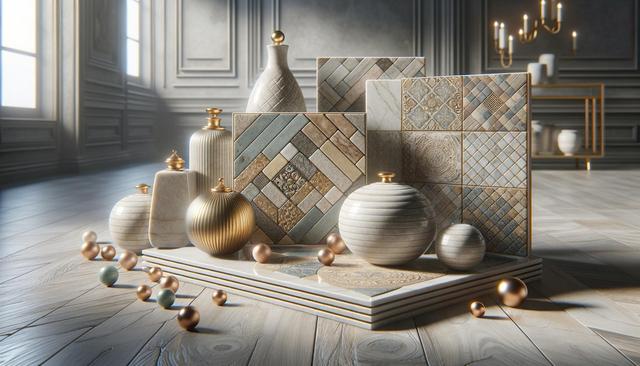A Closer Look at Porcelain Tiles: Durability, Design, and Versatility
Porcelain tiles are a popular choice for both residential and commercial spaces due to their exceptional strength and aesthetic versatility.

Understanding Porcelain and Its Variants
To appreciate the qualities of porcelain tiles, it’s important to understand the differences between common ceramic materials. When comparing earthenware vs stoneware vs porcelain, each has unique characteristics. Earthenware is relatively porous and fired at lower temperatures, making it less durable. Stoneware tiles are denser and more resistant to moisture. Porcelain, however, is fired at the highest temperatures, resulting in a hard, vitrified material that is both water-resistant and highly durable. This distinction becomes critical when choosing materials for high-traffic or moisture-prone areas.
The term porcelain stoneware tiles refers to a category of tiles that combine the density of stoneware with the refined finish of porcelain. These tiles offer a practical and long-lasting solution for floors, walls, and even outdoor applications. Their ability to resist wear and withstand temperature fluctuations makes them a reliable choice in various environments.
What Sets Glazed Porcelain Stoneware Apart
One of the most sought-after finishes in porcelain tiles is the glazed porcelain stoneware. This type of tile features a hard, protective layer of glaze on its surface that not only enhances its appearance but also provides additional durability. The glaze can mimic a wide range of materials, including natural stone, wood, and even concrete, offering design flexibility without compromising performance.
Some of the advantages of glazed porcelain stoneware include:
- Enhanced stain resistance due to the glazed top layer
- Ease of cleaning and maintenance
- Wide range of aesthetic options, including matte, glossy, and textured finishes
- Increased durability for high-traffic areas
Because of these properties, glazed porcelain stoneware is commonly used in kitchens, bathrooms, and commercial spaces like restaurants and retail stores. It combines function with form, making it a practical yet visually appealing solution.
Applications of Porcelain Stoneware Tiles
Porcelain stoneware tiles are incredibly versatile, making them suitable for a wide range of applications. Whether you’re renovating a home or designing a commercial space, these tiles offer both functionality and style. They can be used on floors, walls, countertops, and even as exterior cladding thanks to their weather-resistant properties.
Here are some common areas where porcelain stoneware tiles excel:
- Bathrooms: Moisture resistance and slip-resistant options make them ideal for wet environments.
- Kitchens: Their ability to withstand spills and high foot traffic is a major advantage.
- Living Areas: Stylish designs can mimic natural materials while offering enhanced durability.
- Outdoor Spaces: Frost resistance in certain variants allows for exterior use, including patios and pool areas.
The durability and design variety of porcelain stoneware make it a practical choice for both classic and contemporary interiors. When labeled with specifications such as porcelain stoneware 2370, it often refers to specific tile attributes like color, texture, or format, giving consumers more control over their selection.
Comparing Earthenware, Stoneware, and Porcelain for Your Project
When it comes to choosing between earthenware stoneware and porcelain, it’s essential to match the material to the specific needs of your project. Earthenware may be suitable for decorative items or areas with low wear, while stoneware offers improved durability and is often used in both tableware and tiles. Porcelain stands out for its strength, low porosity, and refined appearance, making it suitable for demanding applications.
Here’s a quick comparison:
- Earthenware: Porous, softer, and less durable; suitable for decorative uses
- Stoneware: Durable and moisture-resistant; suitable for both indoor and outdoor use
- Porcelain: Highly durable, water-resistant, and versatile; ideal for high-traffic and wet areas
Understanding these differences helps ensure that you choose the right material based on performance, appearance, and maintenance needs. Porcelain tiles, particularly those in the porcelain stoneware category, offer a blend of aesthetics and resilience, making them a well-regarded choice in modern architecture and interior design.
Maintaining and Installing Porcelain Tiles
Proper installation and care are key to maximizing the lifespan of your porcelain tiles. These tiles are typically installed using specialized adhesives and grouts that accommodate their low water absorption rate. When installed correctly, porcelain stoneware tiles create a seamless and long-lasting surface that resists damage from heavy use and moisture.
Maintenance is equally straightforward. Regular sweeping and mopping with mild detergents are usually sufficient to keep the tiles looking their best. Glazed porcelain stoneware, in particular, benefits from its protective surface, which repels most stains and makes cleaning easier.
For installation and upkeep, consider the following tips:
- Use a leveling system during installation to avoid uneven surfaces
- Select the right grout color and type to match your tile and environment
- Seal grout lines periodically to maintain a clean look and prevent moisture intrusion
- Clean spills promptly to avoid staining, especially with textured or matte finishes
With proper care, porcelain tiles can maintain their appearance and functionality for decades, making them a cost-effective long-term solution for many types of spaces.